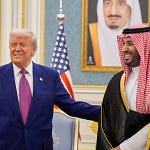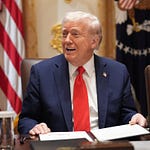It’s worth repeating that President Trump pulled off a major feat yesterday: securing the release of Israeli hostages and and end to the fighting - at least for now - in Gaza.
But as Air Force One lifted off from the Middle East, his “historic dawn of a new Middle East” was already colliding with a far messier reality on the ground—one that suggests the hardest part of ending this war hasn’t even begun.
The cracks appeared before Trump left Jerusalem. While he was still addressing the Knesset, Defense Minister Israel Katz was already signaling what would come next. Hamas had released only four bodies of deceased hostages instead of the 28 promised under the deal. “Each delay or intentional avoidance will be considered a blunt violation of the agreement and will be answered accordingly,” Katz posted on X.
By Tuesday, Israel made good on that threat—cutting humanitarian aid trucks to Gaza by half, from 600 to 300 daily, until Hamas complied.
While Trump celebrated in Egypt, Hamas fighters were moving back into neighborhoods Israeli forces had vacated, deploying hundreds of security personnel. By evening, they made their message clear: in a Gaza City square, Hamas gunmen dragged seven men—hands tied behind their backs—to their knees and shot them in front of dozens of onlookers, accusing them of collaborating with Israel.
Hamas wasn’t fading quietly. They were reasserting control, enforcing authority through violence, and proving that whatever Trump’s plan said about disarmament, they considered themselves very much armed and in charge.
Trump’s response was characteristically bombastic but strategically vague: “They will disarm or we will disarm them. Got it? And it’ll happen quickly and perhaps violently,” he declared.
The gap between Trump’s rhetoric and ground-level reality runs through nearly every element of his plan. The international stabilization force meant to secure Gaza? Still theoretical—no clarity on contributors, funding, or mandate. The interim Palestinian governing committee? Undefined and contentious, with the Palestinian Authority excluded pending vague “reforms.” The $7 billion reconstruction fund? No mechanism for how it will be distributed or monitored. The declaration Trump signed in Egypt with more than a dozen world leaders to great fanfare was more of a statement of principles than a plan.
Trump achieved something significant but incomplete: he used his leverage with Netanyahu to stop the immediate bloodshed and bring hostages home. That’s real—and it matters enormously to the families reunited and to Palestinians no longer being bombed daily.
But the deeper issues remain untouched. Hamas still controls Gaza’s streets. Israel hasn’t abandoned its expansionist aims. The question of Palestinian self-determination is unresolved. And the only forces operating in Gaza remain the same two—Hamas and the IDF—that created this catastrophe in the first place.
Netanyahu knows this better than anyone. While Trump declared victory, Netanyahu told Israelis the war “is not over” and is already laying the groundwork for renewed conflict—waiting for the next pretext: another Hamas attack, weapons-smuggling accusations, aid disputes, or his own political needs. His coalition includes extremists who want to resettle Gaza and reject any Palestinian statehood.
Trump, for his part, showed little interest in the broader political horizon. When pressed aboard Air Force One, he brushed off the question: “We’re talking about rebuilding Gaza. I’m not talking about single state or double state or two state,” he said. “A lot of people like the one-state solution, some people like the two-state solution. We’ll have to see.”
It was revealing. Moments earlier he had declared “the end of the age of terror and death” and “a historic dawn of a new Middle East.” Yet when asked about the central political question that would determine whether that new Middle East ever materializes, his answer was essentially: not my problem.
Getting the hostages home was tangible and headline-grabbing. The slow, grinding work of governance, reconstruction, and political reconciliation is a far less glamorous slog, but it’s what will decide whether Trump’s “historic” moment endures or fades.
President Trump got his victory lap and the headlines. He deserved them. What’s unclear is whether he’ll do the sustained, unglamorous work to turn a tactical win into strategic transformation. Because right now, despite the pageantry in Jerusalem and Egypt, the banners and declarations, the evidence suggests we’re in an intermission—waiting to see whether the next act brings peace or just another round of the same devastating conflict.
Dany and I cover that, and more. Watch and let us know what you think.
Thank you
, , , , , and many others for tuning into my live video with ! Join me for my next live video in the app.












